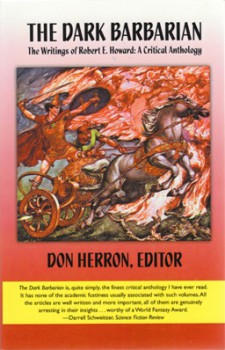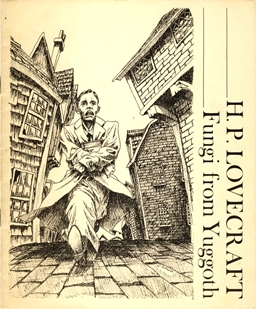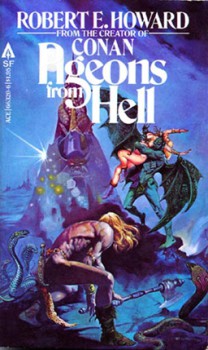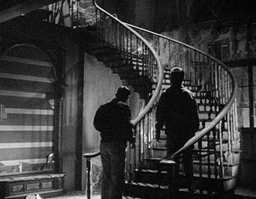Discovering Robert E. Howard: Pigeons From Hell From Lovecraft by Don Herron
 Before the Cumberbunnies took over and flooded the internet with “I heart Sherlock” memes, the term ‘Sherlockian’ referred to those who studied (and often wrote about) Arthur Conan Doyle’s sixty stories of Sherlock Holmes. Some of it was dead serious, some was tongue in cheek and much was in between. Monsignor Ronald Knox’s 1921 “Studies in the Literature of Sherlock Holmes” is the cornerstone of Holmes studies.
Before the Cumberbunnies took over and flooded the internet with “I heart Sherlock” memes, the term ‘Sherlockian’ referred to those who studied (and often wrote about) Arthur Conan Doyle’s sixty stories of Sherlock Holmes. Some of it was dead serious, some was tongue in cheek and much was in between. Monsignor Ronald Knox’s 1921 “Studies in the Literature of Sherlock Holmes” is the cornerstone of Holmes studies.
With that, I tell you that that Don Herron is THE Ronald Knox of Robert E. Howard. “Conan vs. Conantics” and the ensuing “The Dark Barbarian” showed that Howard could be analyzed and treated as literature. As well as something to stir up debate! If you haven’t read the over-600 page essay collection, “The Dark Barbarian That Towers Over All,” you need to pony up $4.99 and get the kindle version now.
And with that, Herron, who is also a noted expert on Dashiell Hammett (this man knows good writing) is going to treat you to a little Howardiana regarding REH’s most chilling horror story, “Pigeons From Hell.”
Recently I did a reread on H. P. Lovecraft’s Fungi from Yuggoth sonnet cycle and had a Hey, Wait a Minute moment. . .
Deep into his follow-up book to A Look Behind the Derleth Mythos, John D. Haefele had asked me to look the poems over. Haefele is surveying Lovecraft’s Great Tales — not just the top achievements, but how the fiction developed as it went along, leading to the break-out stories — not just Lovecraft’s own writing, but how his discoveries of authors such as Robert W. Chambers and Arthur Machen and the ongoing cross-influences of his fellow pulpsters such as Frank Belknap Long, Clark Ashton Smith, and Robert E. Howard display in the ongoing saga that would become known as the Cthulhu Mythos.
 Haefele thought we should check the sonnets, which are like miniature stories in some cases, and ripe with suggestions of the Old Gent’s creativity — the mentions of Innsmouth by the sea and its inhabitants in “VIII. The Port” and “XIX. The Bells” many months before Lovecraft would sit down to write The Shadow over Innsmouth being personal favorites.
Haefele thought we should check the sonnets, which are like miniature stories in some cases, and ripe with suggestions of the Old Gent’s creativity — the mentions of Innsmouth by the sea and its inhabitants in “VIII. The Port” and “XIX. The Bells” many months before Lovecraft would sit down to write The Shadow over Innsmouth being personal favorites.
If you know me largely as a Robert E. Howard critic, you might imagine that I’m not the best backup reader for Haefele’s manuscript, but I’m more than conversant with the whole crew that wrote for Weird Tales. When I was working on “Conan vs. Conantics” in 1976 I was living in St. Paul, Minnesota and hanging out with Richard L. Tierney — who launched modern Lovecraft criticism with his groundbreaking essay “The Derleth Mythos” in 1972.
Dirk Mosig had emerged as the leading figure in that movement, and corresponded with everyone — me included. Another young guy named David E. Schultz drove in from Madison, Wisconsin for the larger local gatherings — did he have any conception at the time how many squiggly holograph letters by Lovecraft he would transcribe in years to come?
So, I’m reading the “Fungi” yet again and come to “X. The Pigeon-Flyers.” This time I stop cold. The word “pigeon” in the title jumps out at me: Did Lovecraft have a thing for pigeons just like Robert E. Howard?
“Pigeons from Hell” today is one of Howard’s most famous stories, ranked as one of the best — read: scariest — horror tales of all time. The scene with the figure coming down the stairs has lifted the hair off the napes of countless readers. That moment alone puts Howard in the master class ranks of the horror tale.
 The title, though — I don’t know that I’ve ever met anyone who thought that title really worked. I guess you could argue that you wouldn’t expect anything really scary to happen in a story called “Pigeons from Hell,” and then Howard sucker punches the bejabbers right out of you.
The title, though — I don’t know that I’ve ever met anyone who thought that title really worked. I guess you could argue that you wouldn’t expect anything really scary to happen in a story called “Pigeons from Hell,” and then Howard sucker punches the bejabbers right out of you.
But “pigeons”. . . ? Even a call-out to the title in “Back on the Chain Gang” by Chrissie Hynde and The Pretenders doesn’t convince me that was the best possible choice.
Instantly — this time — I plunged into research on who used the titular pigeons first, Howard or Lovecraft.
Technically, Lovecraft got there first. The main group of the Fungi were created between December 27, 1929 and January 4, 1930. As a quick romp on Wiki will tell you, The Pigeon-Flyers is a tribute to Henry Everett McNeil, a pal of HPL and a regular in The Kalem Club, who among other things first guided Lovecraft and Frank Belknap Long into Hell’s Kitchen where “sinister pigeon-breeders on filth-choked roofs” sent “birds of space out into black unknown gulfs,” as HPL put it in a memorial letter after “Mac” died — written December 18, 1929 and found in Selected Letters III, pages 92-94. The poem evokes those memories:
They took me slumming…
And from flat roofs a furtive few would fly…
those birds of space had been Outside…
Howard’s “Pigeons from Hell” seems to have been written late in 1934, and wouldn’t see an initial appearance in print until the March 1938 issue of Weird Tales, after both Howard and Lovecraft had died.
That answers the question of Howard or Lovecraft. Easy one.
But how about Howard vs. Lovecraft?
I’ve known of the versus for a long time (see my remarks on the Howard-Lovecraft correspondence in the first issue of Necrofile back in 1992), with their ongoing debates known by the overarching term “Barbarism vs. Civilization” — but I credit my awareness of the rivalry specifically manifesting itself in “Pigeons from Hell” to Brian Leno.
In his essay “Lovecraft’s Southern Vacation” in The Cimmerian V3n2 for February 2006, Leno details how “Pigeons” is a rebuttal to the Lovecraftian idea and milieu of “New England horror.” I’d read the story several times without paying any attention to the fact that the two guys entering the old Southern mansion are from New England. As Leno writes, “at least six times he mentions New England.” For more details track down a copy of the essay, a modern classic in Howard and Lovecraft studies.

Whatever aspect of the ongoing argument set Howard’s creative spark flying in 1934, all the core elements of “Pigeons from Hell” pop to life in the earliest correspondence. A September 1930 letter from Howard to HPL regarding “African-legend sources” contains the major plot kernel of the story, as well as the famous line “But no negro ghost-story ever gave me the horrors as did the tales told by my grandmother,” as well as the seminal “in many of her tales appeared the old, deserted plantation mansion . . . and the ghostly pigeons flying up from the rails of the verandah.”
By then Howard already had read The Fungi from Yuggoth, as acknowledged in his August 9, 1930 letter to Lovecraft. He selected as favorites “The Book,” “The Elder Pharos” and some others, but not ‘The Pigeon-Flyers.” The trick with Howard, however, is that we know his memory — especially for verse — was phenomenal.
His friends reported that he could memorize lengthy poems in just two readings. Without any further proof, I must believe his memory of HPL using pigeons in a title worked its spell on his own title, when the stew of influences came to a boil.
A letter from Howard to Lovecraft later in September 1930 contains what we can now recognize as the kickoff for the game that would result in “Pigeons from Hell.” Howard states, “What a deformed branch on the tree of progress that witch-craft phase of Puritan New England became!” Lovecraft responds on October 4, 1930: “Have you seen my old story ‘The Picture in the House?‘ If not, I must send you a copy. The introductory paragraph virtually sums up the idea you advance.”
In that atmospheric opening, composed December 12, 1920, HPL extols “the ancient, lonely farmhouses of backwoods New England” for forming “the perfection of the hideous.”
In an October 1930 letter Howard mentions that he has never read “Picture” and by December reports receiving “the magazine with your story” — either a copy of the fanzine The National Amateur from 1921 with the first appearance or the reprint in Weird Tales for January 1924. Howard’s first fiction sale, “Spear and Fang,” would not appear in Weird Tales until July 1925.
Other matters and sources of debate surge to the fore, until the moment in 1934 when Howard knocks out “Pigeons from Hell” — and I must note that his tour de force scene of someone descending a staircase completely blows away — destroys — the descent of stairs in “The Picture in the House” — check both, you will agree with me. In fairness to Lovecraft, “Picture” was an early effort, and by 1934 Howard was in peak form.
Oh — and I think Howard fans may want to take a moment to savor another line from The Pigeon-Flyers: “And what they brought from Thog beneath their wings.”
Robert E. Howard would feature Thog, a Tsathoggua-spawn, in his Conan yarn “The Slithering Shadow” in Weird Tales for September 1933. Of course, Tsathoggua was a creation of Clark Ashton Smith, but Howard, Lovecraft and Smith all jumped in on the fun. But that is another essay. . . .
Prior posts in our ‘Discovering Robert E. Howard’ series:
REH Goes Hard Boiled by Bob Byrne
The Fists of Robert E. Howard by Paul Bishop
2015 Howard Days by Damon Sasser
Solomon Kane by Frank Schindiler
REH in the Comics – Beyond Barbarians by Bobby Derie
Rogues in the House by Wally Conger
By Crom – Are Conan Pastiches Official? by Bob Byrne
The Worldbuilding of REH by Jeffrey Shanks
Re-reading ‘The Phoenix on the Sword” by Howard Andrew Jones & Bill Ward
Ramblings on REH by Bob Byrne
There’s plenty more Robert E. Howard coming to Black Gate, so keep checking in!
Don Herron is the author of such essays as “Conan vs. Conantics,” “On Howardian Fairyland,” and more, currently found — along with many asides on H. P. Lovecraft — in the eBook The Dark Barbarian That Towers Over All.
You can read Bob Byrne’s ‘The Public Life of Sherlock Holmes’ column here at Black Gate every Monday morning.
Great article, Don! Of course, if Howard was inspired by Lovecraft, HPL may have taken a page from REH at times as well… In particular, I think Howard’s Solomon Kane tales (particularly “The Moon of Skulls”) inspired Lovecraft’s “The Outpost”: http://www.hplovecraft.com/writings/texts/poetry/p285.aspx
More like Lovecraft influenced Howard.
Nowadays there’s lawsuits at the drop of a hat and they are too afraid of plagiarism but they used to work together and work with and in contrast to their plots. A lot of stories we know today comes from that, for instance C.S. Lewis based his own space/scifi series in counter to Stapledon’s “Last and First Men” over his personal opposition to some themes in it. Also look at “The Haunter of the Dark” for a playful stab at another writer.
Robert E Howard was into historical fiction then used fantasy settings to get around the gaps in real historical knowledge and his own limited knowledge base. (isolated small town, no internet, constant “New” discoveries) Lovecraft influenced him a lot, and yes he probably added some Lovecraft style elements – also plenty of “Sex appeal” which Lovecraft had no taste for.
Although there are plenty of “Lurking Horror” style monsters, like in “The Slithering Shadow” – the best use of such things is to tell the back story – “The Tower of the Elephant” – I don’t have time for full research but it should be recognized as a plot element – in that you have the main character encounter a mover/shaker in the background and that character reveals the history of the fantasy/scifi world – though from his own perspective so its still strange to the hero and open for lots of tweaks and changes.
Oh, wait, most “Fantasy” these days is “I wanna be the next Tolkien – wait – George Martin” and we get massive thick books with tons and tons and tons of history, characters, descriptions…and it’s “I can tell this guy used an RPG online fantasy world generator…”
But IMO – Robert did a passage worthy of a Dunsany story when Conan encountered that sad yet terrifying yet magnificent thing in the tower…
Also note that Lovecraft was heavily influenced by Lord Dunsany.
If Dunsany was George Lucas, Lovecraft would be that guy who met him at EVERY Star Wars convention in a single year, travelling from city to city wearing that same stormtrooper outfit. Lovecraft’s “The Dream Quest of Unknown Kadath” and many others such as “The White Ship” is proof of that.
Not sure if Howard read any Dunsany though HPL had to have mentioned him. And again Howard was clearly more talented, some of his passages such as the one at Tower of the Elephant were worthy of Dunsany almost.
Howard mentions Dunsany a couple of times in his letters. Of course, the real common influence for both Lovecraft and Howard (and Clark Ashton Smith) was Arthur Machen; Howard’s “Little Person” stories are largely a continuation of the theme of Machen’s own tales like “The Novel of the Black Stone,” “The Shining Pyramid,” etc. – and of course, Howard and Lovecraft discussed Machen and his “Little Person” stories at some length in their letters; one of Lovecraft’s mini-essays on the subject (marrying Machen to Margaret Murray’s Witch-Cult) was later excerpted and published as “Some Backgrounds on Fairy-Land.”